The Cambridge History of Japan, Vol. 4: Early Modern Japan
Подождите немного. Документ загружается.

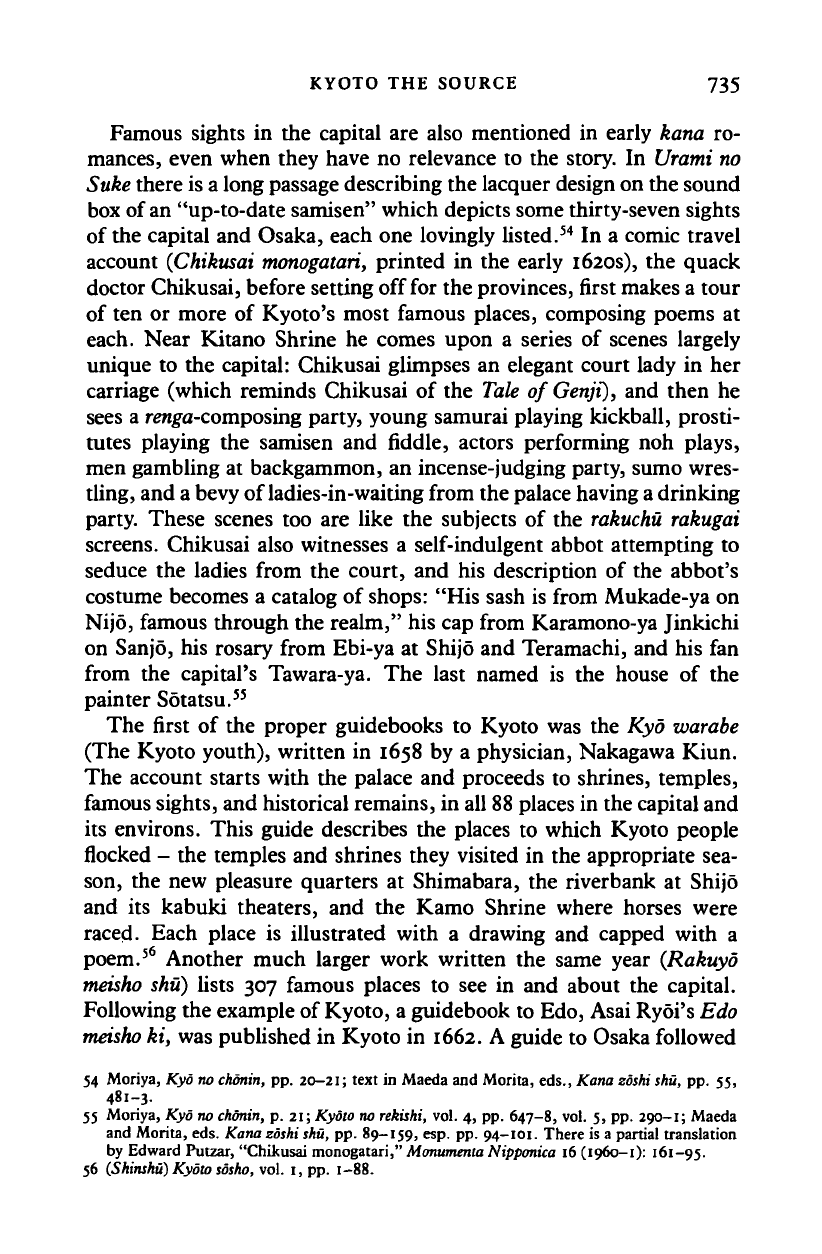
KYOTO THE SOURCE 735
Famous sights in the capital are also mentioned in early kana ro-
mances, even when they have no relevance to the story. In
Urami
no
Suke there is a long passage describing the lacquer design on the sound
box of
an
"up-to-date samisen" which depicts some thirty-seven sights
of the capital and Osaka, each one lovingly listed.
54
In a comic travel
account
(Chikusai
monogatari,
printed in the early 1620s), the quack
doctor Chikusai, before setting off for the provinces, first makes a tour
of ten or more of Kyoto's most famous places, composing poems at
each. Near Kitano Shrine he comes upon a series of scenes largely
unique to the capital: Chikusai glimpses an elegant court lady in her
carriage (which reminds Chikusai of the
Tale
of
Genji),
and then he
sees a renga-composing party, young samurai playing kickball, prosti-
tutes playing the samisen and fiddle, actors performing noh plays,
men gambling at backgammon, an incense-judging party, sumo wres-
tling, and a bevy of ladies-in-waiting from the palace having
a
drinking
party. These scenes too are like the subjects of the
rakuchu
rakugai
screens. Chikusai also witnesses a self-indulgent abbot attempting to
seduce the ladies from the court, and his description of the abbot's
costume becomes a catalog of
shops:
"His sash is from Mukade-ya on
Nijo,
famous through the realm," his cap from Karamono-ya Jinkichi
on Sanjo, his rosary from Ebi-ya at Shijo and Teramachi, and his fan
from the capital's Tawara-ya. The last named is the house of the
painter Sotatsu.
55
The first of the proper guidebooks to Kyoto was the Kyo
warabe
(The Kyoto youth), written in 1658 by a physician, Nakagawa Kiun.
The account starts with the palace and proceeds to shrines, temples,
famous sights, and historical remains, in all
88
places in the capital and
its environs. This guide describes the places to which Kyoto people
flocked - the temples and shrines they visited in the appropriate sea-
son, the new pleasure quarters at Shimabara, the riverbank at Shijo
and its kabuki theaters, and the Kamo Shrine where horses were
raced. Each place is illustrated with a drawing and capped with a
poem.
56
Another much larger work written the same year (Rakuyo
tneisho
shu) lists 307 famous places to see in and about the capital.
Following the example of
Kyoto,
a guidebook to Edo, Asai Ryoi's Edo
meisho
ki, was published in Kyoto in 1662. A guide to Osaka followed
54 Moriya, Kyo no
chonin,
pp.
20-21;
text in Maeda and Morita, eds., Kana zoshi
shu,
pp. 55,
481-3.
55 Moriya, Kyo no
chonin,
p. 21; Kyoto no rekishi, vol. 4, pp. 647-8, vol. 5, pp.
290-1;
Maeda
and Morita, eds. Kana zoshi
shu,
pp. 89-159, esp. pp. 94-101. There is a partial translation
by Edward Putzar, "Chikusai monogatari,"
Monumenta
Nipponica 16 (1960-1): 161-95.
56
(Shinshu)
Kyoto
sosko,
vol. 1, pp. 1-88.
Cambridge Histories Online © Cambridge University Press, 2008
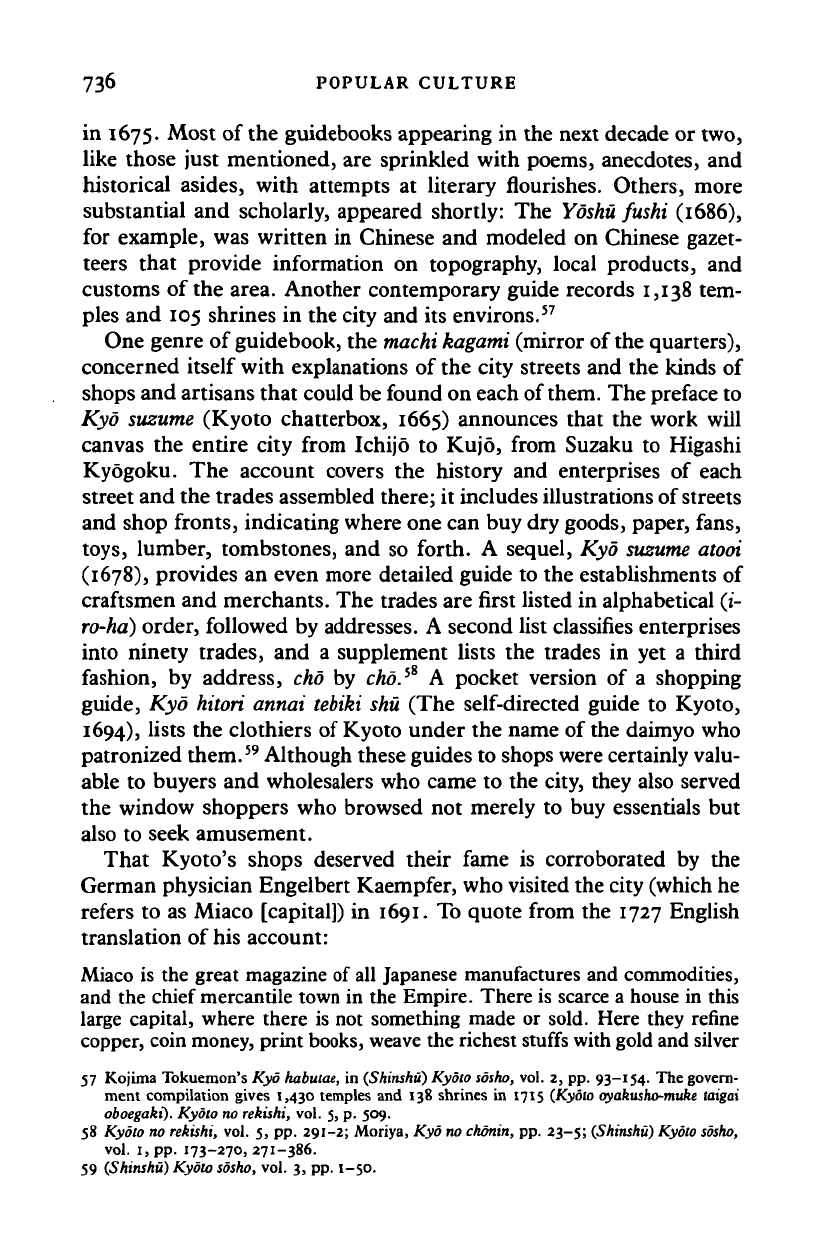
736 POPULAR CULTURE
in 1675. Most
of
the guidebooks appearing
in
the next decade
or
two,
like those just mentioned,
are
sprinkled with poems, anecdotes,
and
historical asides, with attempts
at
literary flourishes. Others, more
substantial
and
scholarly, appeared shortly:
The
Yoshu
fushi (1686),
for example,
was
written
in
Chinese
and
modeled
on
Chinese gazet-
teers that provide information
on
topography, local products,
and
customs
of
the area. Another contemporary guide records
1,138 tem-
ples
and
105 shrines
in
the city and
its
environs.
57
One genre
of
guidebook,
the
machi kagami
(mirror
of
the quarters),
concerned itself with explanations
of
the city streets
and the
kinds
of
shops and artisans that could be found on each of them. The preface
to
Kyo suzume (Kyoto chatterbox,
1665)
announces that
the
work will
canvas
the
entire city from Ichijo
to
Kujo, from Suzaku
to
Higashi
Kyogoku.
The
account covers
the
history
and
enterprises
of
each
street and the trades assembled there;
it
includes illustrations of streets
and shop fronts, indicating where one can buy dry goods, paper, fans,
toys,
lumber, tombstones,
and so
forth.
A
sequel,
Kyo
suzume atooi
(1678),
provides
an
even more detailed guide
to the
establishments
of
craftsmen
and
merchants.
The
trades are first listed
in
alphabetical
(i-
ro-ha)
order, followed
by
addresses. A second list classifies enterprises
into ninety trades,
and a
supplement lists
the
trades
in yet a
third
fashion,
by
address, cho
by
cho.
sS
A
pocket version
of a
shopping
guide,
Kyo
hitori annai
tebiki shit
(The
self-directed guide
to
Kyoto,
1694),
lists
the
clothiers
of
Kyoto under
the
name
of
the daimyo
who
patronized them.
59
Although these guides to shops were certainly valu-
able
to
buyers
and
wholesalers who came
to the
city, they also served
the window shoppers
who
browsed
not
merely
to buy
essentials
but
also
to
seek amusement.
That Kyoto's shops deserved their fame
is
corroborated
by the
German physician Engelbert Kaempfer, who visited the city (which he
refers
to as
Miaco [capital])
in
1691.
To
quote from
the
1727 English
translation
of
his account:
Miaco
is
the great magazine of all Japanese manufactures and commodities,
and the chief mercantile town
in
the Empire. There is scarce a house in this
large capital, where there
is not
something made
or
sold. Here they refine
copper, coin money, print
books,
weave the richest stuffs with gold and silver
57 Kojima Tokuemon's
Kyo
habmae,
in
(Shinshu) Kyoto
sdsho,
vol. 2, pp.
93-154. The govern-
ment compilation gives
1,430
temples
and 138
shrines
in 1715
(Kyoto
oyakusho-muke
taigai
oboegaki).
Kyoto no rekishi,
vol. 5, p. 509.
58 Kyoto no rekishi,
vol. 5, pp.
291-2; Moriya,
Kyo
no
chonin,
pp.
23-5;
(Shinshu)
Kyoto
sdsho,
vol. 1, pp. 173-270, 271-386.
59
(Shinshu) Kyoto
sdsho,
vol. 3, pp. 1-50.
Cambridge Histories Online © Cambridge University Press, 2008
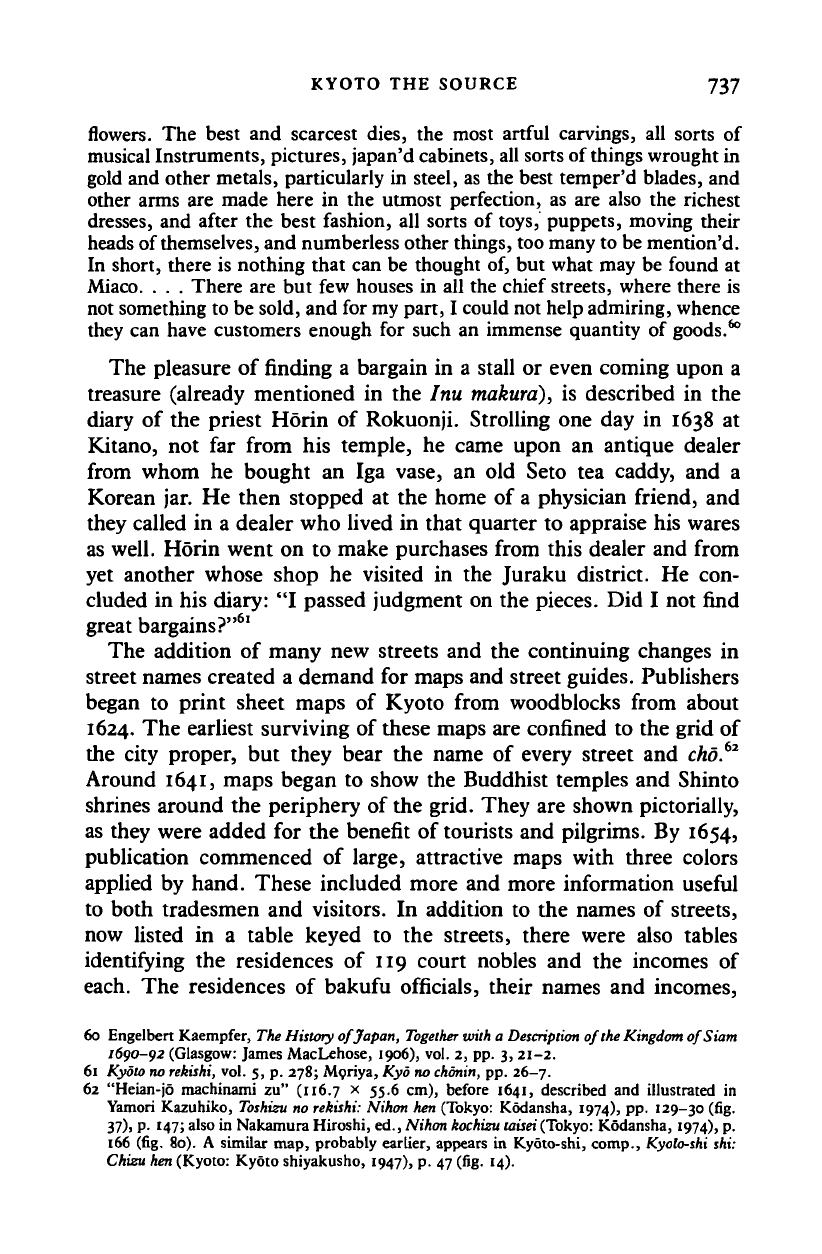
KYOTO THE SOURCE 737
flowers. The best and scarcest dies, the most artful carvings, all sorts of
musical Instruments, pictures, japan'd cabinets, all sorts of
things
wrought in
gold and other metals, particularly in steel, as the best temper'd blades, and
other arms are made here in the utmost perfection, as are also the richest
dresses, and after the best fashion, all sorts of toys, puppets, moving their
heads of themselves, and numberless other things, too many to be mention'd.
In short, there is nothing that can be thought of, but what may be found at
Miaco. . . . There are but few houses in all the chief streets, where there is
not something to be sold, and for my part, I could not help admiring, whence
they can have customers enough for such an immense quantity of goods.
60
The pleasure of finding a bargain in a stall or even coming upon a
treasure (already mentioned in the Inu
makura),
is described in the
diary of the priest Horin of Rokuonji. Strolling one day in 1638 at
Kitano, not far from his temple, he came upon an antique dealer
from whom he bought an Iga vase, an old Seto tea caddy, and a
Korean jar. He then stopped at the home of a physician friend, and
they called in a dealer who lived in that quarter to appraise his wares
as well. Horin went on to make purchases from this dealer and from
yet another whose shop he visited in the Juraku district. He con-
cluded in his diary: "I passed judgment on the pieces. Did I not find
great bargains?"
61
The addition of many new streets and the continuing changes in
street names created a demand for maps and street guides. Publishers
began to print sheet maps of Kyoto from woodblocks from about
1624.
The earliest surviving of these maps are confined to the grid of
the city proper, but they bear the name of every street and cho.
62
Around 1641, maps began to show the Buddhist temples and Shinto
shrines around the periphery of the grid. They are shown pictorially,
as they were added for the benefit of tourists and pilgrims. By 1654,
publication commenced of large, attractive maps with three colors
applied by hand. These included more and more information useful
to both tradesmen and visitors. In addition to the names of streets,
now listed in a table keyed to the streets, there were also tables
identifying the residences of 119 court nobles and the incomes of
each. The residences of bakufu officials, their names and incomes,
60 Engelbert Kaempfer, The History of Japan,
Together
with a
Description
of
the
Kingdom ofSiam
1690-92 (Glasgow: James MacLehose, 1906), vol. 2, pp. 3, 21-2.
61 Kyoto no
rekishi,
vol. 5, p. 278; Moriya, Kyo no
chonin,
pp. 26-7.
62 "Heian-jo machinami zu" (116.7 x 55.6 cm), before 1641, described and illustrated in
Yamori Kazuhiko,
Toshizu
no rekishi: Nihon hen (Tokyo: Kodansha, 1974), pp. 129-30 (fig.
37),
p. 147; also in Nakamura Hiroshi, ed., Nihon
kochizu taisei
(Tokyo:
Kodansha, 1974), p.
166 (fig. 80). A similar map, probably earlier, appears in Kyoto-shi, comp., Kyolo-shi shi:
Chizu
hen
(Kyoto: Kyoto shiyakusho, 1947), p. 47 (fig. 14).
Cambridge Histories Online © Cambridge University Press, 2008

738 POPULAR CULTURE
and the location of daimyo mansions appeared as well. Temples,
shrines, and palaces came to be boldly marked and color coded. The
word rakugai added to the title informs us that famous temples and
historical sites in the environs of the capital have been crowded into
the margins.
63
A
new generation of large,
five-colored
maps began in 1686. In these
maps,
Hideyoshi's Great Buddha was clearly the prime tourist attrac-
tion: The dimensions of
all
of its parts and other trivia were also listed
in map tables.
64
Tourists could find, too, in the northeast corner of
some of the maps, a description and history of Enryakuji on Alt. Hiei.
Additional lists and tables accounted for the major Buddhist sects, and
the number of their branch temples and landholdings, the names of
the entrances to the city, the distances to other towns and cities in the
vicinity, the length and width of major bridges, and so forth. In fact,
maps of Kyoto became a type of guidebook. In the eagerness to in-
clude factual information, the effectiveness of the map was somewhat
compromised: The tables obscure, for example, streets and roads on
the west side of the southern suburb of
Fushimi.
When drawing roads
outside the grid, any notion of scale was abandoned in favor of includ-
ing the outlying sights of Mt. Hiei, Uji, and Yodo within the corners of
the map. Indeed, the attention to illustration and artistry was so keen
that publishers employed recognized artists to embellish their maps
and, so, to tempt buyers. Like the multivolume guidebooks, the large,
attractive maps had lasting appeal as precious souvenirs of the capital
and entertainment for the vicarious traveler. Several Kyoto publishers
reissued their maps every few years, recarving sections of the wood-
blocks to update information. Evidently there were map collectors, for
one shop advertised a supply of old maps for antiquarians.
65
As some of the tables on maps suggest, interest in Kyoto's notable
people was as intense as interest in Kyoto's notable places. Thus it is
not surprising that a guidebook called Kyo
habuiae
(Warp and woof
of
Kyoto, 1685) devotes its last two fascicles to a who's who of the city's
important residents. Under the name of each imperial prince and court
noble we find his rank, crest, annual income, address, age, and the
names of his main retainers. Following a similar catalog of daimyo,
this guide lists the bakufu officials stationed in Kyoto. In addition, to
63 "Shimpan Heian-jo tozai namboku machinami rakugai no zu" (134.9
x
87.0 cm), published
by Muan (1654), in Yamori,
Toshi
zu no
rekishi,
pp. 141-5. A 1662 revision is reproduced in
Kyoto-shi shi: Chizu hen, pp. 52-3 (fig. 18).
64 "Shinsen zoho Kyo oezu" (165.2 x 124.8 cm), 1686, in Yamori,
Toshi
zu no
rekishi,
p. 144
(fig. 47), p. 146. Reproduced in Kyoto-shi
shi:
Chizu
hen,
pp. 54—55 (fig. 19).
65 Yamori,
Toshi
zu no rekishi, p. 148.
Cambridge Histories Online © Cambridge University Press, 2008

KYOTO THE SOURCE 739
the catalog of
241
master-teachers described earlier, there is also a list
of leading artisans and dealers.
66
Information concerning the names and addresses of bushi resident
in Edo was of particular importance to the tradesmen of that city, and
as early as 1647 and 1651, registers of
buke
(warrior) houses, called
bukan
("mirror of the buke"), were privately compiled and printed by
book dealers. The daimyo
bukan
list name, domain, assessed yield in
koku, court rank, name of heir, dates of arrival and departure for
sankin
kotai, crest, design of pikes and standards used in processions,
locations of the daimyo's several residences in Edo, and other informa-
tion. In later times annual revisions were published. There were also
bukan
of bakufu officials and of
hatamoto
(bannermen).
A characteristic of Japanese culture that has found expression in
literature and painting since Heian times is an awareness of changing
seasons and a desire to engage in activities appropriate to the phase of
the calendar. Hence guidebooks included information on which places
were best visited, and when. Screen paintings had earlier represented
Kyoto places in their best seasons: Higashiyama and its cherry trees in
spring, the Kamo River bank with its cool breezes in the evenings of
summer, Arashiyama to the west with its maples in the fall, Inari on
the south for the fire festival in winter. In the same way that poems
since the
Kokinshu
(the first imperial anthology of 905) had associated
celebrated sights around the capital with a season, Edo paintings and
popular songs made seasonal references to Kyoto places.
Published handbooks, such as the Annaisha (1662), which were
exclusively guides to the calendar for the Kyoto resident, recorded
events through the year
(nenju gydji)
that were observed in the capital.
Among the more detailed was the Hinami kiji (1685) which listed
events day by day under seven categories: observances in the imperial
household, celebrations at Shinto shrines, official ceremonies, prac-
tices of the common people, memorial anniversaries, the showing of
hidden treasures by temples and shrines, and Buddhist services. Of
the 3,100 events recorded in this work, over half are still observed in
Kyoto today. If the guides described earlier dealt with city space, these
charted city time - the rhythm of urban life.
67
It is evident from popu-
lar stories as well as guides to the calendar that visiting temples and
shrines on days of festivals or other special events was a favorite form
of entertainment. Temples drew crowds by announcing the days on
66
(Shinshu)
Kyoto
sosho,
vol. 2, pp. 155-238; Kyoto no
rekishi,
vol. 5, pp. 508-10.
67 Akai, "Genroku ki no toshi seikatsu to minshu bunka," pp. 335-6; Moriya, Kyo no chonin,
pp.
30—1;
Kyoto no
rekishi,
vol. 5, pp. 293-6.
Cambridge Histories Online © Cambridge University Press, 2008
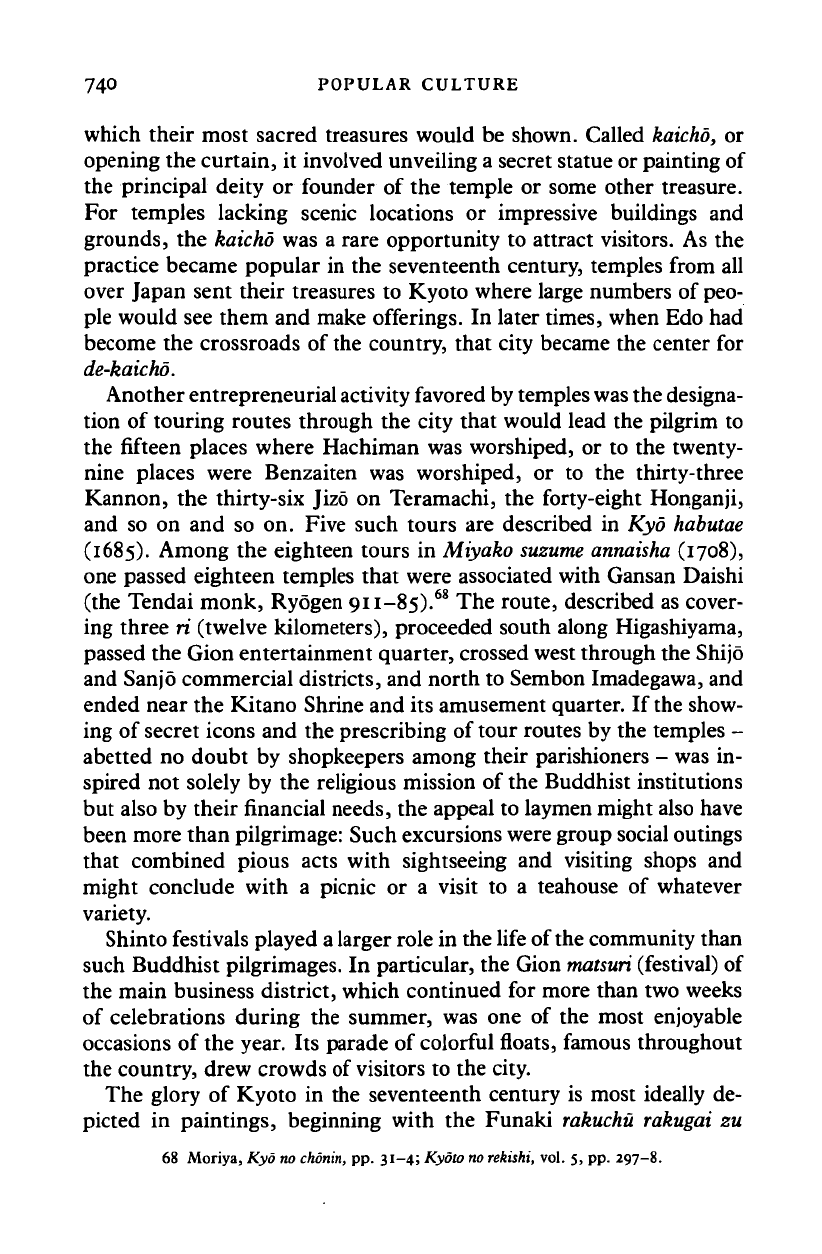
74° POPULAR CULTURE
which their most sacred treasures would be shown. Called
kaicho,
or
opening the curtain, it involved unveiling a secret statue or painting of
the principal deity or founder of the temple or some other treasure.
For temples lacking scenic locations or impressive buildings and
grounds, the kaicho was a rare opportunity to attract visitors. As the
practice became popular in the seventeenth century, temples from all
over Japan sent their treasures to Kyoto where large numbers of peo-
ple would see them and make offerings. In later times, when Edo had
become the crossroads of the country, that city became the center for
de-kaicho.
Another entrepreneurial activity favored by temples
was
the designa-
tion of touring routes through the city that would lead the pilgrim to
the fifteen places where Hachiman was worshiped, or to the twenty-
nine places were Benzaiten was worshiped, or to the thirty-three
Kannon, the thirty-six Jizo on Teramachi, the forty-eight Honganji,
and so on and so on. Five such tours are described in Kyo
habutae
(1685).
Among the eighteen tours in Miyako
suzume annaisha
(1708),
one passed eighteen temples that were associated with Gansan Daishi
(the Tendai monk, Ryogen 911-85).
68
The route, described as cover-
ing three ri (twelve kilometers), proceeded south along Higashiyama,
passed the Gion entertainment quarter, crossed west through the Shijo
and San jo commercial districts, and north to Sembon Imadegawa, and
ended near the Kitano Shrine and its amusement quarter. If the show-
ing of secret icons and the prescribing of tour routes by the temples -
abetted no doubt by shopkeepers among their parishioners - was in-
spired not solely by the religious mission of the Buddhist institutions
but also by their financial needs, the appeal to laymen might also have
been more than pilgrimage: Such excursions were group social outings
that combined pious acts with sightseeing and visiting shops and
might conclude with a picnic or a visit to a teahouse of whatever
variety.
Shinto festivals played
a
larger role in the life of the community than
such Buddhist pilgrimages. In particular, the Gion
matsuri
(festival) of
the main business district, which continued for more than two weeks
of celebrations during the summer, was one of the most enjoyable
occasions of the year. Its parade of colorful floats, famous throughout
the country, drew crowds of visitors to the city.
The glory of Kyoto in the seventeenth century is most ideally de-
picted in paintings, beginning with the Funaki
rakuchu rakugai
zu
68 Moriya, Kyo no chonin, pp. 31-4; Kyoto no rekishi, vol. 5, pp. 297-8.
Cambridge Histories Online © Cambridge University Press, 2008
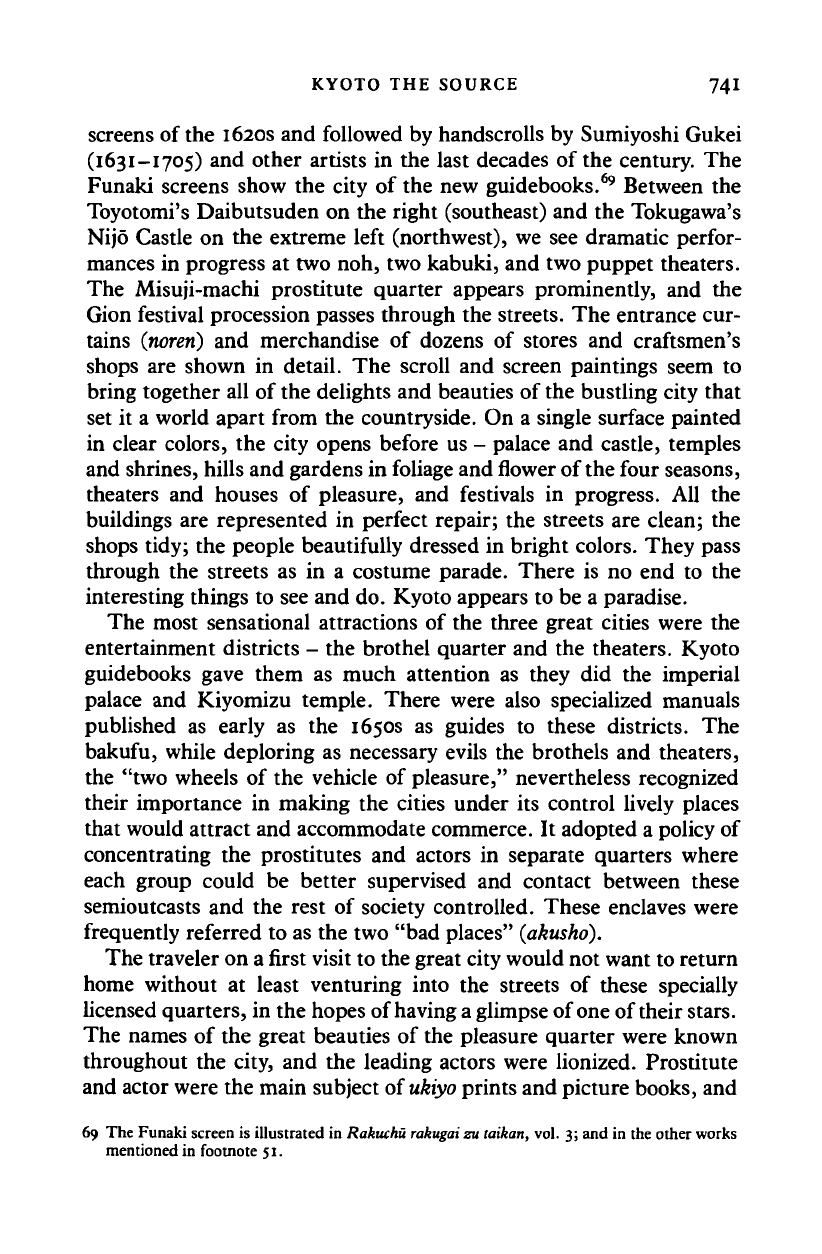
KYOTO THE SOURCE 741
screens of the 1620s and followed by handscrolls by Sumiyoshi Gukei
(1631-1705) and other artists in the last decades of the century. The
Funaki screens show the city of the new guidebooks.
69
Between the
Toyotomi's Daibutsuden on the right (southeast) and the Tokugawa's
Nijo Castle on the extreme left (northwest), we see dramatic perfor-
mances in progress at two noh, two kabuki, and two puppet theaters.
The Misuji-machi prostitute quarter appears prominently, and the
Gion festival procession passes through the streets. The entrance cur-
tains
(noreri)
and merchandise of dozens of stores and craftsmen's
shops are shown in detail. The scroll and screen paintings seem to
bring together all of the delights and beauties of the bustling city that
set it a world apart from the countryside. On a single surface painted
in clear colors, the city opens before us - palace and castle, temples
and shrines, hills and gardens in foliage and
flower
of the four seasons,
theaters and houses of pleasure, and festivals in progress. All the
buildings are represented in perfect repair; the streets are clean; the
shops tidy; the people beautifully dressed in bright colors. They pass
through the streets as in a costume parade. There is no end to the
interesting things to see and do. Kyoto appears to be a paradise.
The most sensational attractions of the three great cities were the
entertainment districts - the brothel quarter and the theaters. Kyoto
guidebooks gave them as much attention as they did the imperial
palace and Kiyomizu temple. There were also specialized manuals
published as early as the 1650s as guides to these districts. The
bakufu, while deploring as necessary evils the brothels and theaters,
the "two wheels of the vehicle of pleasure," nevertheless recognized
their importance in making the cities under its control lively places
that would attract and accommodate commerce. It adopted a policy of
concentrating the prostitutes and actors in separate quarters where
each group could be better supervised and contact between these
semioutcasts and the rest of society controlled. These enclaves were
frequently referred to as the two "bad places"
(akusho).
The traveler on a first visit to the great city would not want to return
home without at least venturing into the streets of these specially
licensed quarters, in the hopes of having a glimpse of one of their stars.
The names of the great beauties of the pleasure quarter were known
throughout the city, and the leading actors were lionized. Prostitute
and actor were the main subject of
ukiyo
prints and picture books, and
69 The Funaki screen is illustrated in
Rakuchu rakugai
zu
laikan,
vol. 3; and in the other works
mentioned in footnote 51.
Cambridge Histories Online © Cambridge University Press, 2008

742 POPULAR CULTURE
details
of
their lives were publicized outrageously.
To the end of the
Edo period,
the
life
of
the brothel quarter, especially, was an absorbing
subject
in the
ukiyo zoshi
and later literary genres such as
sharebon
and
gokan.
It
was
a
rare kabuki or puppet play that
did not
locate
a
scene
in
a brothel.
The two
pleasure quarters were
the
source
of
up-to-date
fashions, music, song,
and
other elements
of
popular culture that
spread throughout urban society. Both quarters became centers
of
social life,
not
simply
for
personal places
of
recreation,
but
also
for
wining, dining,
and
entertaining customers.
70
THE SOCIETY
OF
PROSTITUTES
In
1589
Hideyoshi
had the
brothels
in the
city
of
Kyoto brought
together
in one
licensed quarter known
as
Nijo Yanagi-machi,
in the
eastern part
of the
strip
of
land that still remained deserted between
the upper
and
lower city.
71
In 1602,
when
the
Tokugawa built Nijo
Castle, they moved
the
brothels away
to a
quarter known
as
Rokujd
Misuji-machi
and in
1640 transferred them
for
the last time
to an
even
more remote location,
the
fields
in
the extreme southwest corner of the
city wall, beyond
the
great compounds
of
Buddhist temples. This
quarter, which came
to
be called
the
Shimabara, measured 200
by 240
meters
and was
surrounded
by an
earthen wall
and a
moat
3
meters
wide.
The
single entrance,
a
guarded gate
on the
east side, made
it
possible
to
keep under surveillance those entering
the
quarter
-
fugitives who might seek refuge there
and
ronin
and
other troublemak-
ers.
It
also prevented prostitutes from leaving to ply their trade outside
the quarter.
72
A similar policy
was
followed
in Edo. In 1617 the
various brothels
were brought together
to
form
the
Yoshiwara quarter
on
reclaimed
land
a
short distance east
of
Nihombashi.
But the
business district
developed around
the
quarter,
and Edo
Castle itself
was
not far
away.
When
the
Meireki fire
of 1657
destroyed this part
of the
city,
the
bakufu seized
the
opportunity
to
move
the
houses
to a
location given
the name Shin Yoshiwara, outside
the
city
in the
open fields beyond
70 Donald H. Shively, "The Social Environment of Tokugawa Kabuki," in James R. Brandon,
William P. Malm, and Donald H. Shively, eds., Studies in Kabuki: Its Acting, Music, and
Historical Context (Honolulu: University of Hawaii Press, 1978), pp. 1-61, esp. pp. 50-4.
71 Hideyoshi established a licensed quarter in Osaka in 1585 at the time when he was construct-
ing Osaka Castle. This is believed to be the first instance of a segregated, licensed quarter.
Ono Takeo, Yoshiwara, Shimabara (Tokyo: Kyoikusha, 1978), p. 32. However, there was
licensing of prostitutes from at least the late twelfth century.
72 Kyoto no
rekishi,
vol. 4, pp. 590-2, vol. 5, pp. 167-72.
Cambridge Histories Online © Cambridge University Press, 2008

THE SOCIETY OF PROSTITUTES 743
Asakusa Temple,
a
distance of six kilometers from the center of
Edo.
A
walled enclave like the Shimabara was constructed, with the bakufu
contributing generously to help
finance
the relocation.
73
In Osaka, too,
the authorities began in 1631 to bring brothels together to form the
Shimmachi quarter on swampy land on the western edge of the city.
The licensing of these quarters followed a common pattern. Hide-
yoshi issued the Kyoto license to two former samurai who organized
and administered the quarter. Decades later, the Tokugawa contracted
with individuals of samurai background when the Edo and Osaka
quarters were established. They received extensive authority to admin-
ister the quarters and keep order. Because the clientele in the early
decades of
the
Edo period was predominantly bushi of all ranks, it was
essential to take a firm hand to prevent outbreaks of violence among
the pleasure seekers. The cavorting of samurai, foot soldiers, monks,
and
chonin
in the streets and houses of the Misuji-machi quarter is
clearly recorded in the Funaki screens.
74
Although the quarter offered women of a wide range of rank and
price to all comers, it was the presence of
a
few celebrated beauties of
wit and cultural accomplishments who created the mystique of the
courtesan. A small number of the highest rank were known as
tayu,
a
title (originally meaning "great minister") used by noh actors, but also
assumed by the kabuki actors and actresses who performed the leading
roles on the Shijo stages. Some were proficient in dancing, singing, or
playing musical instruments, of course, and also in classical poetry,
haikai, tea, and other arts. They dressed in magnificent robes and
were sought by daimyo, upper bushi, and court nobles who sum-
moned them to their residences and, in a few instances, even bought
them from their proprietors. Tayu were, in fact, known as daimyo
dogu, or daimyo's articles, as though they were tea bowls or other
treasured objects collected by the great lords.
75
Some participated in
the social life of the elite, according to an early record of the
Yoshiwara, which says: "During the Keicho and Genna eras [1596-
1624],
men of the most distinguished families invited intimates, tell-
ing them that a certain
tayu,
engaged for several days, would make tea
at a certain person's house."
76
There also were reports that
tayu
were
73 Ishii Ryosuke,
Yoshiwara
(Tokyo: Chuo koronsha, 1967), pp. 4-12, 21-7; Gunji Masakatsu,
Kabuki to
Yoshiwara
(Tokyo: Awaji shobd, 1956), pp. 96-102.
74 Rakuchu
rakugai
zu taikan, vol. 3, pp. 56-9, 64-67; Kyoto
no
rekishi,
vol. 4, p. 590.
75 Kyoto no
rekishi,
vol. 5, pp. 268-72; Ishii,
Yoshiwara,
pp. 13-18, 94-5, 119; Gunji, Kabuki to
Yoshiwara, pp.
140-1.
76 Sakata, Chonin, p. 20, quoting (Ikon) Dobo goen (1720), Enseki jisshu, III, vols. 27-29 of
Kokusho kankokai
sosho,
series 1, 1908, p. 3.
Cambridge Histories Online © Cambridge University Press, 2008
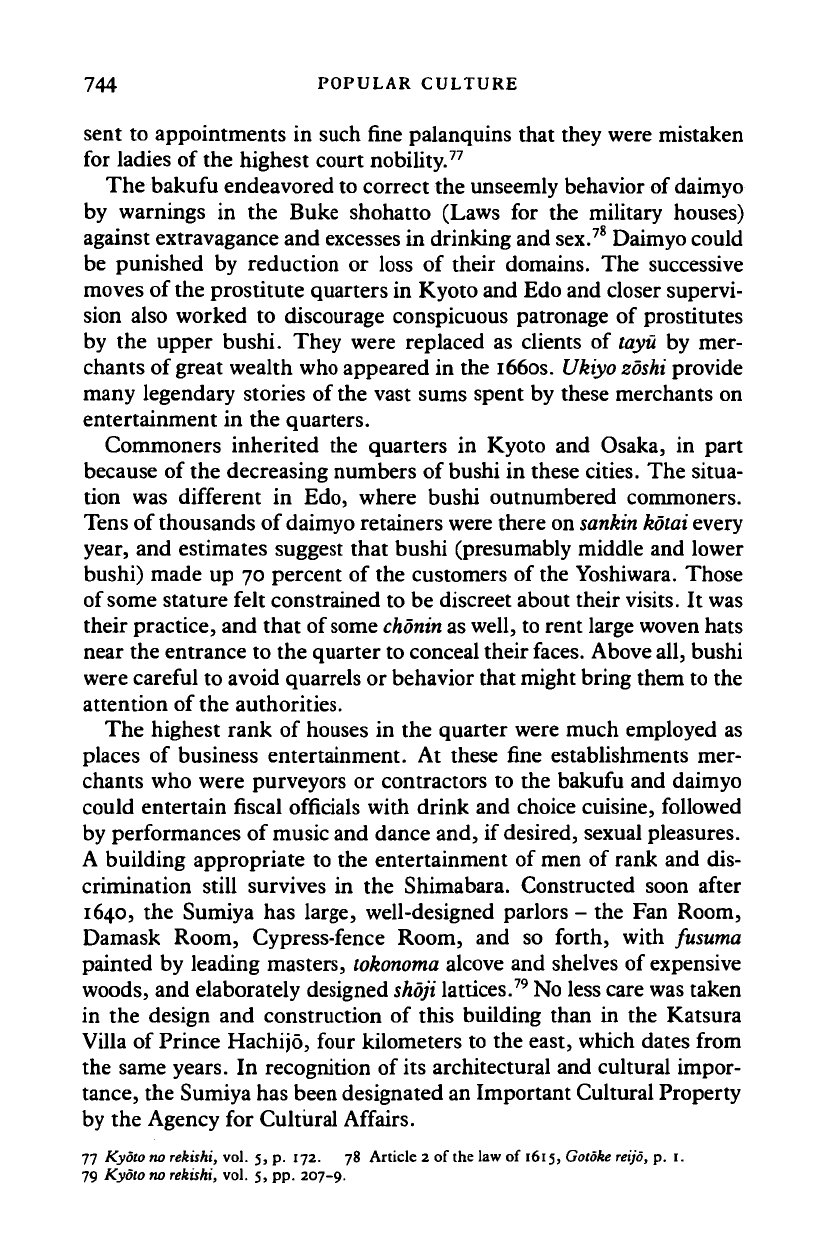
744 POPULAR CULTURE
sent to appointments in such fine palanquins that they were mistaken
for ladies of the highest court nobility.
77
The bakufu endeavored to correct the unseemly behavior of daimyo
by warnings in the Buke shohatto (Laws for the military houses)
against extravagance and excesses in drinking and sex.
78
Daimyo could
be punished by reduction or loss of their domains. The successive
moves of the prostitute quarters in Kyoto and Edo and closer supervi-
sion also worked to discourage conspicuous patronage of prostitutes
by the upper bushi. They were replaced as clients of
tayu
by mer-
chants of great wealth who appeared in the 1660s.
Ukiyo zoshi
provide
many legendary stories of the vast sums spent by these merchants on
entertainment in the quarters.
Commoners inherited the quarters in Kyoto and Osaka, in part
because of the decreasing numbers of bushi in these cities. The situa-
tion was different in Edo, where bushi outnumbered commoners.
Tens of thousands of
daimyo
retainers were there on
sankin kotai
every
year, and estimates suggest that bushi (presumably middle and lower
bushi) made up 70 percent of the customers of the Yoshiwara. Those
of some stature felt constrained to be discreet about their
visits.
It was
their practice, and that of some
chonin
as well, to rent large woven hats
near the entrance to the quarter to conceal their faces. Above
all,
bushi
were careful to avoid quarrels or behavior that might bring them to the
attention of the authorities.
The highest rank of houses in the quarter were much employed as
places of business entertainment. At these fine establishments mer-
chants who were purveyors or contractors to the bakufu and daimyo
could entertain fiscal officials with drink and choice cuisine, followed
by performances of music and dance and, if desired, sexual pleasures.
A building appropriate to the entertainment of men of rank and dis-
crimination still survives in the Shimabara. Constructed soon after
1640,
the Sumiya has large, well-designed parlors - the Fan Room,
Damask Room, Cypress-fence Room, and so forth, with fusuma
painted by leading masters,
tokonoma
alcove and shelves of expensive
woods, and elaborately designed
skoji
lattices.
79
No less care was taken
in the design and construction of this building than in the Katsura
Villa of Prince Hachijo, four kilometers to the east, which dates from
the same years. In recognition of its architectural and cultural impor-
tance, the Sumiya has been designated an Important Cultural Property
by the Agency for Cultural Affairs.
77 Kyoto no rekishi, vol. 5, p. 172. 78 Article 2 of the law of 1615, Gotoke reijo, p. I.
79 Kyoto no rekishi, vol. 5, pp. 207-9.
Cambridge Histories Online © Cambridge University Press, 2008
